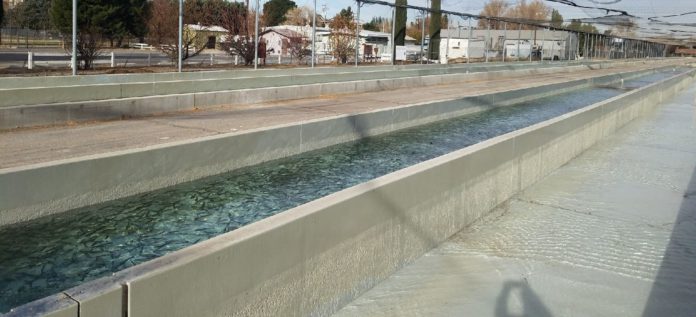Over 60,000 trout have died at Mojave Narrows
BY JIM MATTHEWS, Special to Western Outdoor News
A bacterial outbreak at the Mojave River Hatchery in Victorville has already killed 60,000 of the 650,000 trout at this Department of Fish and Wildlife facility, according to Jay Rowan, the environmental program manager with the DFW hatchery program in Sacramento. Two other hatchery facilities in Inyo County have also tested positive for the deadly bacteria, but they have not experienced any fish losses.
The outbreak has led to the immediate cessation of trout plants throughout Southern California, and that is expected to continue for at least the foreseeable future. This means the end of all trout plants in Ventura, Santa Barbara, Los Angeles, San Bernardino, Riverside, San Diego, and Imperial counties through at least the rest of the summer. There will also be a reduction of plants in Inyo and Mono counties because both the Black Rock and Fish Springs hatcheries in Inyo County have also tested positive for the bacteria, but the Hot Creek hatchery remains negative for the bacteria and trout will continue to be planted from this facility.
The bacterium Lactococcus garvieae is a new bug in trout hatcheries, not found before 1950 and then only in the Far East infecting rainbow trout, yellowtail, and grey mullet in both hatchery and wild settings. It wasn’t until 1988 that it appeared outside of this region when it appeared in a European trout hatchery. It has since spread slowly, but this is the first outbreak in California.
While little is known about the bacterium, it is similar to streptococcus and infected fish show symptoms that including bulging eyes, lethargic or erratic swimming, and eventually death. Some fish carrying the bacteria may be asymptomatic, assisting spread. Out of caution and not wanting to spread the bacteria to wild populations, the DFW has ceased all plants from infected hatcheries until more is learned about its mortality and prevalence. Testing is ongoing at all other DFW hatchery facilities, but none have tested positive so far.
There is only one treatment for the bacteria in large hatchery settings, and Rowan said it has been ineffective at the Mojave River Hatchery.
“Our only option is not working well on the bacteria [at Mojave]. We’ve been treating for some time now, but 60,000 trout have died so far despite the treatments. The death rate just keeps going up, up, up,” said Rowan.
Dieoffs in Black Rock and Fish Springs have not been observed, and Rowan said this was because it is believed the bacteria become more virulent as water temperatures warm. In recent weeks, the water temperature at Mojave River has increased into the low 60s, while the Sierra hatcheries still have water temperatures in the mid-50s.
“We don’t have tried-and-true strategies on hand to combat it,” said Rowan. “A successful approach would have three components: Treating the affected fish at the hatcheries, finding the origin of the outbreak, and planning ahead to contain and prevent the spread of the bacteria.
“Unfortunately, we may be in for a long battle here, which means there will not be a lot of fish plants in the near future in the eastern Sierra and Southern California. I wish we could give anglers a target date for when we think we can start planting again, especially since our one treatment option does not appear to be working right now,” said Rowan.
Southern California’s other hatchery, the Fillmore Hatchery, is just now coming back on line after water problems and maintenance for over a year. It was just starting to receive fish for fall and winter plants at the three major state water project reservoirs in Southern California: Castaic, Pyramid, and Silverwood. It is being tested for the bacteria this week.
The DFW has not put a value on the losses of trout to this point because the losses have been across all age groups of fish at Mojave River, and this is just the early stages of the outbreak.




